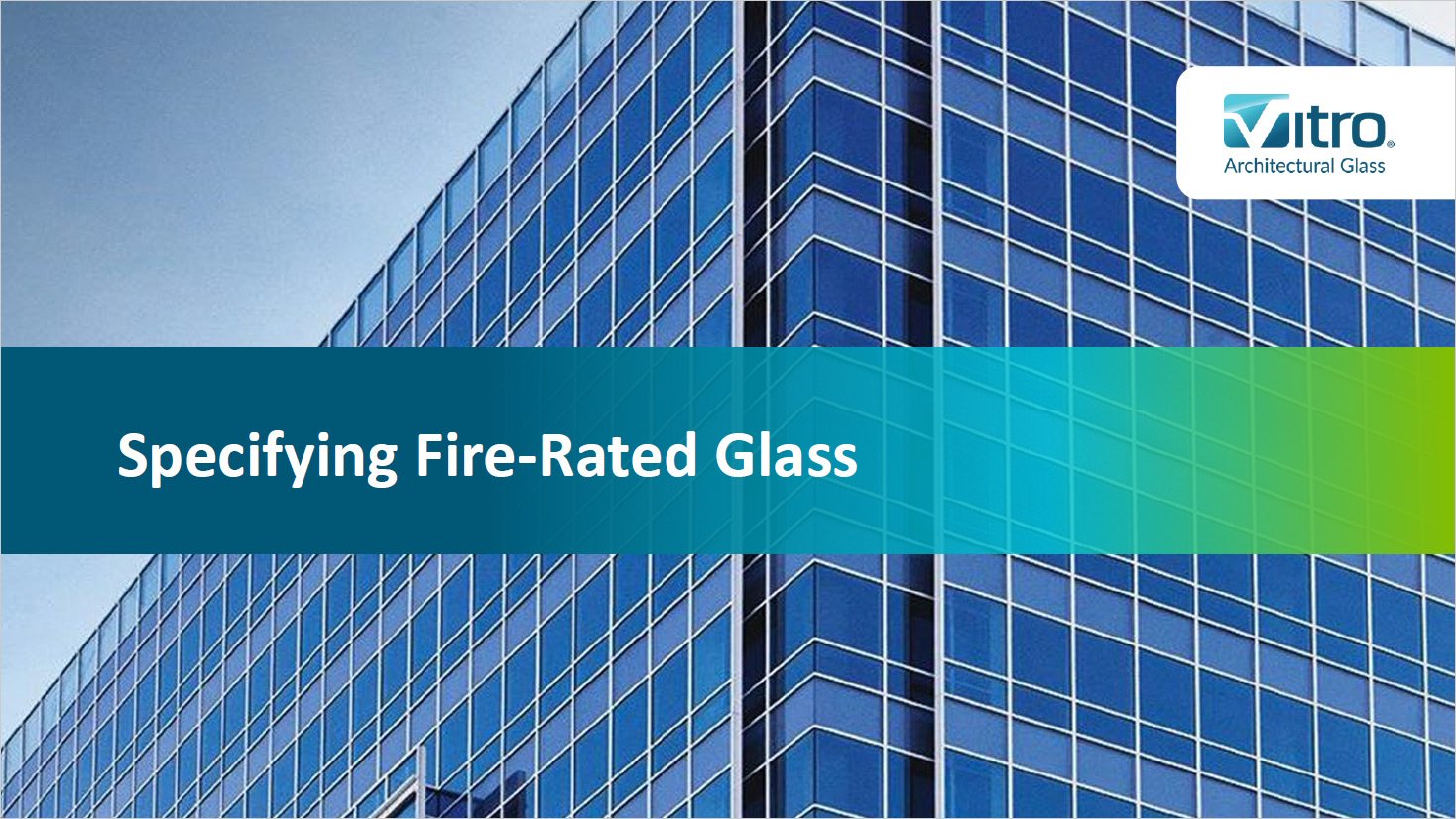Glass is vital to the aesthetic of nearly every modern structure—increasing natural light, curbing sound, protecting against inclement weather and offering a view to the external world. While glass has always been favored for its aesthetic versatility, it has quietly and reliably evolved into a critical component that can add beauty, structural integrity and fire protection to rooms and buildings, as well.
Fire-rated glass is classified as a life-safety building material. Governed by the International Building Code (IBC), the glass is rated according to how it performs in standardized testing that measures the amount of time it will help stop the spread of fire and smoke. Typical clear window glass will fail at temperature differences approaching 250 degrees F. High-performance, fire-rated glasses, which typically look similar to standard window glass, can protect people and property in temperatures exceeding 1,600 degrees F.
Fire-rated glass is divided into two distinct categories: fire-protective and fire-resistive glass. To effectively protect occupants and the structural integrity of buildings, it is vital that glass specifiers, designers and other building professionals understand the performance and tolerances specified within each category and, even more important, the key differences between the two types. The first step is to understand how glass is fire tested.
Fire Testing
In its most basic terms, fire-rated glass is categorized according to the amount of time it stays in place and effectively compartmentalizes fire and smoke. Formal testing procedures for glass fire ratings are standardized in American Society for Testing and Materials (ASTM) E 119, Standard Test Methods for Fire Tests of Building & Construction Materials.
During these tests, fire-rated glass is subjected to temperatures exceeding 1,600 degrees for 45 minutes or longer. Based on the amount of time the glass remained fixed in place, it is assigned a 20-, 45- or 60- minute (or longer) fire rating. The rate by which temperatures increase during these tests also is regulated to simulate stages of an actual fire.
After being heated according to ASTM guidelines, the glass is then subjected to a hose-stream test in keeping with simulated fire scenarios. In accordance with NFPA 257 Standard on Fire Test for Window and Glass Block Assemblies, last updated in 2017, the hose stream test applies an even stream of water to the glass from a two-man fire hose. The test simulates the rapid cooling of glass when exposed to water, which forecasts its ability to stay intact during activation of sprinklers or fire extinguishment by safety personnel.
Certain applications also require impact testing based on the area of coverage. Impact tests, which are made with a pendulum-based strike using a standardized weight, determine the resistance and strength of glass against breakage. The height of the drop determines the level of impact resistance for adherence to code.
The results of these standardized tests—expressed in time—enable architects and designers to choose glass products that will meet code for specific applications. In most instances, these results must be documented through labeling.
Performance Labeling
In 2012, the IBC began requiring fire-rated glazing to include a product label that building and design professionals could use to identify a product’s performance capabilities. The labels clearly state which tests the glass has passed, the building applications most appropriate for its use, conformance with test criteria and prescribed fire rating.
These labels correlate with codes designating specific performance characteristics and limits for glass based on their fire-resistive or fire-protective capabilities, as well as the impact resistance of installed glass.
Fire-Protective Glass
Fire-protective glass commonly includes special tempered glass, as well as ceramics and hollow metal framing. Although such glazings are engineered to protect against the spread of flames and smoke—and to achieve fire ratings that range from 20 to 180 minutes—they are still restricted by code to specific applications. The main restricting factor for fire-protective glass is that it is not designed to prevent transmission of radiant heat.
As a result of their potential for transmitting radiant heat, glasses rated as fire-protective cannot exceed 25% of the total area of a wall. For that reason, fire-protective glass is most commonly specified for use within opening-protective assemblies, 1-hour walls and door vision panels. Other permitted applications for fire-protective glass include doors and openings of less than 100 square inches in size.
Due to variations by application and locality, fire-protective glass also may be subject to additional testing standards, including:
- NFPA 252 – Standard Methods of Fire Tests of Door Assemblies
- NFPA 257 – Standard on Fire Tests for Window and Glass Block Assemblies
- Underwriters Laboratories (UL) 9 – Standard for Safety Fire Tests of Window Assemblies
- UL 10 B – Fire Tests of Door Assemblies
- UL 10 C – Positive Pressure Fire Tests of Door Assemblies
It is essential to research such localized variations to ensure compliance.
Fire-Resistive Glass
The primary differentiator of fire-resistive (sometimes called fire-resistant) glass is its ability to restrict radiant heat. Fire-resistive glass will not conduct heat—protecting occupants from extreme temperature transmission through the glass, as well as ignition of additional potential fires sparked by radiant heat.
Fire-resistive glass restricts fire and smoke for longer periods of time and has demonstrated, through testing, that it will limit temperatures to 250 degrees F or less on its protected side for the duration of its designated time rating. In addition to having fire ratings of 20 minutes to three hours, fire-resistive glass also has a wide range of prescribed applications.
To prevent the transmission of radiant heat, fire-resistive glazings are manufactured with several layers of intumescent materials that swell and turn opaque when subjected to heat. The expansion of these layers creates a barrier that prevents heat radiation and thereby protects occupants of the building or room. When activated, these intumescent materials can extend protection from radiant heat by up to three hours—depending on the specified glazing.
This level of protection enables fire-resistive glass to be specified for enclosures (including stairwells), interior dividers, exit corridors and other applications where fire barriers are required. In addition, the use of fire-resistive glass dramatically limits code restrictions on size and applications for use.
Due to variations by application and locality, fire-resistive glass also may be subject to additional testing standards, including:
- ASTM E-119 – Standard Methods for Fire Tests of Building Construction and Materials
- NFPA 251 – Standard Methods of Test of Fire Resistance of Building and Construction Materials
- UL 263 – Fire Tests of Building Construction Materials.
Framing Requirements
Framing elements for fire-protective and fire-resistive glazings must achieve the same levels of compliance, meaning they have been tested to stay in place for the same amount of time during a fire as the glasses they contain. Today’s test protocols normally require that the whole product, including the glazing and framing materials, be subjected to the specified testing.
In fire-protective scenarios, where neither the glass nor framing are required to provide a radiant barrier, metal framing is frequently used. Hollow metal framing used with 45-minute fire-protective glass must be able to hold the glass in place for at least 45 minutes.
Likewise, in scenarios where fire-resistive glass is specified, the framing also must block the radiation of heat for the rated time period. To achieve the required levels of fire-resistance, framing material is typically coated with glazing or insulation that meets appropriate code and testing requirements.
Summary and Additional Information
Understanding the differences between fire-protective and fire-resistive glass is vital to code compliance and occupant safety, as each term explicitly defines the type and volume of glass that can be used in a given application.
In summary, fire-protective glass is tested to measure its ability to prevent the spread of fire and smoke during its prescribed rating period. Fire-resistive glass performs the same function, yet also restricts the spread of radiant heat to protect occupants and prevents combustion. To achieve code compliance, framing elements must match the prescribed level of fire rating for the glass and glazing.
IBC requires that fire-protective and fire-resistive glass be labeled to indicate their designated levels of protection. It is important for specifiers of fire-rated glass to know how to interpret the labeling so the products they specify for a specific application meet all related codes in a particular jurisdiction.
ASTM, IBC, NFPA and UL provide detailed information for understanding codes, standards, testing and applications. To learn more about fire-rated glass and how to determine which option is best suited for a specific application, visit vitroglazings.com.
Learn more about our full line of Low-E Glass products.
Updated on February 8, 2023





